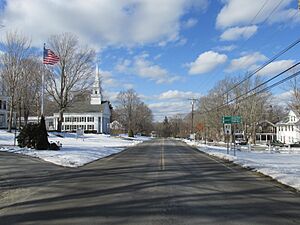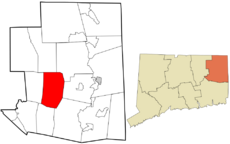Hampton, Connecticut facts for kids
Quick facts for kids
Hampton, Connecticut
|
||
|---|---|---|
| Town of Hampton | ||

Route 97 in Hampton
|
||
|
||
 Windham County and Connecticut Windham County and Connecticut |
||
| Country | ||
| U.S. state | ||
| County | Windham | |
| Region | Northeastern CT | |
| Incorporated | 1786 | |
| Government | ||
| • Type | Selectman-town meeting | |
| Area | ||
| • Total | 25.5 sq mi (66.0 km2) | |
| • Land | 25.0 sq mi (64.8 km2) | |
| • Water | 0.5 sq mi (1.3 km2) | |
| Elevation | 696 ft (212 m) | |
| Population
(2020)
|
||
| • Total | 1,728 | |
| • Density | 67.76/sq mi (26.182/km2) | |
| Time zone | UTC-5 (Eastern) | |
| • Summer (DST) | UTC-4 (Eastern) | |
| ZIP code |
06247
|
|
| Area code(s) | 860/959 | |
| FIPS code | 09-36000 | |
| GNIS feature ID | 0213441 | |
Hampton is a small town in Windham County, Connecticut. It is part of the Northeastern Connecticut Planning Region. In 2020, about 1,728 people lived there.
Contents
Geography of Hampton
Hampton covers an area of about 25.5 square miles (66 km2). Most of this area, about 25.0 square miles (65 km2), is land. The rest, about 0.5 square miles (1.3 km2), is water.
Hampton's Climate and Seasons
Hampton has a humid continental climate. This means it experiences all four seasons: winter, spring, summer, and fall.
Spring warmth usually begins in mid-April. Nights can still be cold, but they get warmer until June. Summer temperatures stay steady for about three months. Then, temperatures start to drop for fall. Fall days and nights are generally warmer than spring. The first frost in fall usually happens in October. However, some plants like peas and carrots can survive until November, when the colder weather truly begins.
| Climate data for Hampton, Connecticut(1991-2020 normals) | |||||||||||||
|---|---|---|---|---|---|---|---|---|---|---|---|---|---|
| Month | Jan | Feb | Mar | Apr | May | Jun | Jul | Aug | Sep | Oct | Nov | Dec | Year |
| Mean daily maximum °F (°C) | 36.2 (2.3) |
38.3 (3.5) |
46.1 (7.8) |
57.6 (14.2) |
67.6 (19.8) |
75.4 (24.1) |
80.4 (26.9) |
78.9 (26.1) |
72.5 (22.5) |
61.8 (16.6) |
51.2 (10.7) |
41.1 (5.1) |
58.9 (15.0) |
| Daily mean °F (°C) | 26.8 (−2.9) |
28.1 (−2.2) |
35.6 (2.0) |
46.1 (7.8) |
56.3 (13.5) |
64.9 (18.3) |
70.2 (21.2) |
68.5 (20.3) |
62.0 (16.7) |
51.0 (10.6) |
41.1 (5.1) |
32.0 (0.0) |
48.5 (9.2) |
| Mean daily minimum °F (°C) | 17.4 (−8.1) |
18.0 (−7.8) |
25.2 (−3.8) |
34.6 (1.4) |
45.1 (7.3) |
54.4 (12.4) |
60.0 (15.6) |
58.0 (14.4) |
51.4 (10.8) |
40.2 (4.6) |
31.0 (−0.6) |
23.0 (−5.0) |
38.2 (3.4) |
| Average precipitation inches (mm) | 4.05 (103) |
3.37 (86) |
4.44 (113) |
4.67 (119) |
3.74 (95) |
4.32 (110) |
3.91 (99) |
4.21 (107) |
4.31 (109) |
4.73 (120) |
4.11 (104) |
4.78 (121) |
50.64 (1,286) |
| Source: https://www.weather.gov/wrh/Climate?wfo=box | |||||||||||||
History of Hampton
Hampton was formed from parts of other towns like Pomfret and Windham. It officially became its own town in 1786.
The Congregational Church in Hampton is very old. Parts of it date back to 1754, making it the second oldest church in Connecticut still in use.
Another interesting building is "The House the Women Built." It's a two-story house built in 1776. Young women from the town, including Sally Bowers, built it while the men were away fighting in the Continental Army.
At Clark's Corner, there's a special pole called a liberty pole from 1849. A resident named Jonathan Clark put it up. It shows the distances to other towns, including Hartford.
Places to Visit in Hampton
Hampton has some historic places that are recognized nationally:
- Hampton Hill Historic District – This area was added to the National Register of Historic Places in 1982. It's a great place to see old buildings.
- Hemlock Glen Industrial Archeological District – This district was added to the National Register of Historic Places in 2007. It shows signs of old industries.
Famous People from Hampton
Many interesting people have connections to Hampton:
- William H. Barnes – A well-known judge.
- John Brewster Jr. (1766–1854) – He was a deaf painter who traveled a lot. He was born in Hampton.
- Royal B. Farnum (1884–1967) – He was the president of the Athenæum and Mechanics Institute.
- Martin Flint (1782–1855) – A political and military leader in Vermont. He was involved with the Anti-Masonic Party.
- Edwin Way Teale (1899–1980) – A famous naturalist and author. He lived on a farm in Hampton from 1959 until he passed away. His book A Naturalist Buys an Old Farm tells about his time there. His farm, called Trail Wood, is now a nature preserve.
- Theodore Dwight Weld (1803–1895) – An author and important figure in the movement to end slavery. He was born in Hampton and lived there until 1825.
- Annie Withey – She helped start Annie's Homegrown and invented Smartfood. She lived in Hampton with her husband.
Hampton's Population and Community
| Historical population | |||
|---|---|---|---|
| Census | Pop. | %± | |
| 1820 | 1,313 | — | |
| 1850 | 946 | — | |
| 1860 | 936 | −1.1% | |
| 1870 | 891 | −4.8% | |
| 1880 | 827 | −7.2% | |
| 1890 | 632 | −23.6% | |
| 1900 | 629 | −0.5% | |
| 1910 | 583 | −7.3% | |
| 1920 | 475 | −18.5% | |
| 1930 | 511 | 7.6% | |
| 1940 | 535 | 4.7% | |
| 1950 | 672 | 25.6% | |
| 1960 | 934 | 39.0% | |
| 1970 | 1,129 | 20.9% | |
| 1980 | 1,322 | 17.1% | |
| 1990 | 1,578 | 19.4% | |
| 2000 | 1,758 | 11.4% | |
| 2010 | 1,863 | 6.0% | |
| 2020 | 1,728 | −7.2% | |
| U.S. Decennial Census | |||
In 2000, there were 1,758 people living in Hampton. There were 674 households and 494 families. About 33.8% of households had children under 18. Most households (62.6%) were married couples.
The average household had about 2.61 people, and the average family had about 3.04 people. The median age in Hampton was 40 years old. This means half the people were younger than 40 and half were older.
The median income for a household was $54,464. For families, it was $66,339. The income per person in the town was $25,344. About 3.5% of the population lived below the poverty line.
Images for kids
See also
 In Spanish: Hampton (Connecticut) para niños
In Spanish: Hampton (Connecticut) para niños



